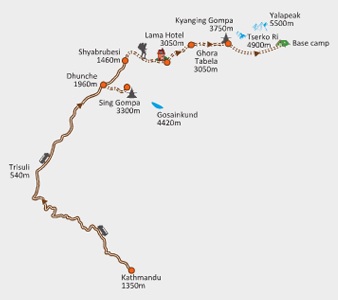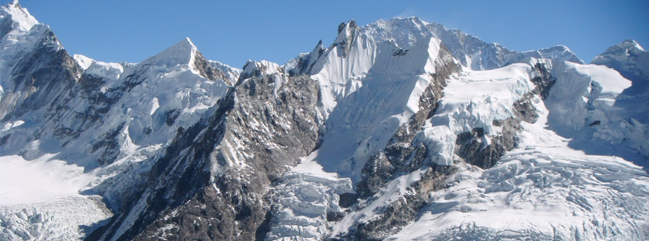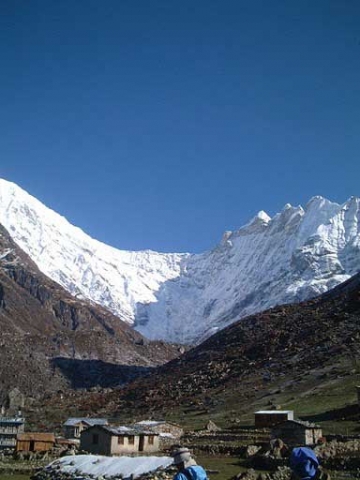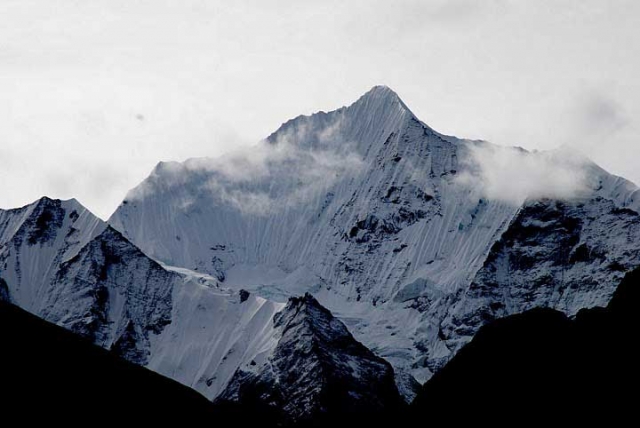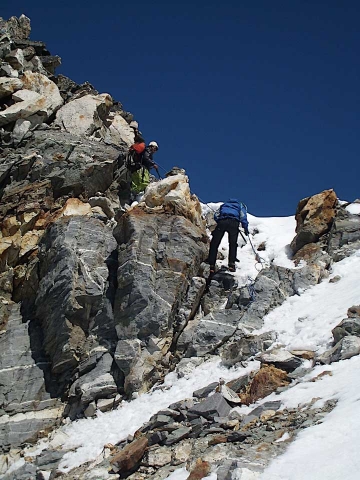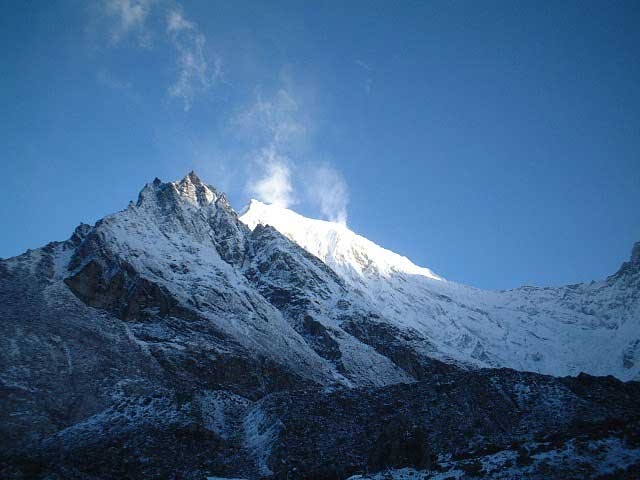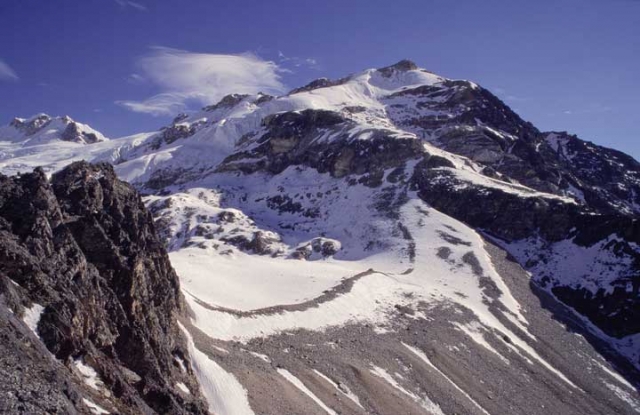Yala Peak is one of Nepal’s easier trekking peaks, just to the north of Kathmandu in the beautiful Langtang valley region, this 5500 meters peak does not require mountaineering experience. From Katmandu we drive to Dhunche or Syabru Bensi, and then trek up the valley for Four days. We explore the Langshisa glacier to help us acclimatize, establishing a high camp at 4800 meters from where we make our summit. After an alpine start under stars we are on the summit by late morning, with some amazing views into Tibet and across to Shisapangma (the only 8000 meters peak situated wholly in Tibet).This trek enables you to explore through the Langtang National Park home of the Tibetan looking people the Tamangs. We begin our journey by drive towards the North West of Kathmandu to a mountain village of Dhunche a major village of Langtang area.
The trek commences from here to the farmland, villages and forest of Rhododendron, conifer, bamboos, oaks and pines. In the spring season forest looks enchanting with flowers all around. After passing this fascinating scenery we follow the narrow gorge of Langtang River till we ascend to the large alpine grass land of Kyangin Gompa where the glacier meets the meadow. You can see Yaks grazing around with the backdrops of snowy peaks of Langtang Ri, Langtang Lirung, Dorjee Lakpa and many other unnamed mountains around you.
Day 01 – Arrival in Kathmandu airport (1345meters).
There you will be met by our Airport Representative and transferred to hotel by private tourist vehicle. Overnight at hotel.
Day 02 – Sightseeing around Kathmandu valley.
In the morning after breakfast at 9 AM, we host a Pre-Trip meeting at your hotel in Kathmandu and introduced your trek Leader/Guide mean time and it will provide an opportunity for individuals to ask questions about the your trek and to introduce you to other participants. This includes a final briefing and preparations for the trip.
PLEASE ADVISE US IF YOU WILL BE ARRIVING LATE AND ARE THEREFORE UNABLE TO ATTEND THE PRE-TRIP MEETING.
In THE PRE-TRIP MEETING All passengers MUST bring:
1. Passport.
2. Four copies of Passport size photos each.
3. Travel Insurance Policy.
4. A writing pen
5. Notepad.
After the Pre-Trip meeting and breakfast your sightseeing trip will start at 9.45 AM in the morning. We provide a private vehicle and professional tour guide. We visit Bodhnath Stupa, one of the biggest Buddhist shrines in the world, where we observe Buddhist monks in prayer in the monasteries surrounding the stupa. After Bodhnath Stupa we visit Pashupatinath, the most famous Hindu temple in the country, located on the banks of the holy Bagmati River. Here we see Hindu holy men (sadhus) meditating, pilgrims bathing and occasionally funeral pyres burning on the ghats. We also visit Bhaktapur Durbar Square, which is a collection of pagoda and shikhara – style temples grouped around a fifty-five-window palace of brick and wood. The attraction of the Bhaktapur Durbar Square is The Lion gate, The Golden gate, The Palace of fifty five windows, Art Galleries, The Statue of King Bhupatindra Malla.
The rest of our time in Kathmandu is free for further exploration and some last-minute shopping in Thamel area near by your. Overnight at hotel.
Day 03 – Drive to Sybru Bensi (1462meters) by bus 8 hours.
Drive from Kathmandu to Syabru Besi which takes about nine hours by bus or Land cruiser depending on group size. You head north out of Kathmandu driving through scenic foothills and ridgeline vistas to Syabru Besi passing through Dhunche. While passing along the road at the bank of Trishuli river you catch a glimpse of Ganesh Himal, terraces and green hills. As you pass through Dhunche you feel as if you are heading towards deep land. At the same time, you notice that the road is still under construction. Sybru Bensi the cool town with the excellent view. Overnight at guesthouse.
Day 04 – Trek to Lama Hotel (2500meters) 5 hours.
Today, the first part of the trail crosses through Bhote Koshi and follows the Langtang Khola. This trail gradually climbs to Bamboo passing through the landslide area. Afterwards, your trek ascends gently to Rimche (2400meters) through Bamboo (1960meters) which lies at the bank of Langtang Khola. You can have lunch at this place if you like. Your trail is level to the Lama Hotel. En route you could see red pandas, monkeys and bears if you’re lucky. Overnight at guesthouse.
Day 05 – Trek to Langtang Village (3307meters) 5 hours.
The trek route follows Gumanechok, Ghoda Tabela literally it means the Horse Stable. After this the trail is slightly gradual and beautiful in the valley with the grazing Yaks. Langtang village is one of the very local and old villages along this trekking route and the view from here is more spectacular as we get closer to mountain. Overnight at guesthouse.
Day 06 – Trek to Kyanjin Gompa (3798meters) 4 hours.
Today is a shorter walk but enough for acclimatization. The surroundings are interesting and we pass the famous Cheese factory. This beautiful valley in the lap of the Langtang Lirung. A place to explore the valley and lots of small peaks to climb. Overnight at guesthouse.
Day 07 – Kyanjin Gompa exploration day.
Today is a day to rest and explore the area. You can visit the monastery and cheese factory then take a walk up the moraine to see the spectacular ice faces and tumbling glaciers of Langtang Lirung or ascend Kyangjin Ri (4350meters) which is highest point of this trek, directly behind the village, for a breath-taking panorama of the Langtang peaks. Overnight at guesthouse.
Day 08 – Trek to Yala peak Base camp (4400meters) 6 hours.
To reach Yala Base Camp you trek along the rocky glacier trail. You will be quite taken back by the views of Ganchenpo, Naya Kang, Tserko Ri, Yala peak and others. For today the accommodation will be tented camp and food will be cooked by our professional camp cook. Overnight at Tented camp.
Day 09 – Summit Yala Peak (5732 meters) and back to Kyangjin Gompa.
Today our main adventure day, an early start in the morning to climb Pisang peak depending on weather conditions. At the summit of Yala peak, you will be stunned by the panoramic views of Shishapangma, Dorje Lakpa, Ganchenpo, Naya Kang, Tserko Ri, Langtang Lirung and many Tibetan mountains. Overnight at guesthouse.
Day 10 – Spare day in case of bad weather to climb Yala Peak.
Day 11 – Trek back to Lama Hotel (2500meters) 5.30 hours.
Rejoin the trail to Lama Hotel. Overnight at guesthouse.
Day 12 – Trek to Sybru Bensi (1462meters) 5 hours.
Leaving the mountains behind us our descent takes us to the Sybru Bensi where we started the trek about a week ago. Overnight at guesthouse.
Day 13 – Drive back to Kathmandu by bus 8 hours.
After breakfast, we drive back to Kathmandu from Sybru Bensi which will take some 9 hours by bus or Land cruiser depending on group size. Overnight at hotel.
Day 14 – Leisure day in Kathmandu.
Extra day in Kathmandu for relaxing and some shopping, if you are interested in continuing onto Chitwan Jungle Safari, River Rafting Adventure, Kathmandu Shopping Tour or Scenic Everest Flight.
Day 15 – Transfer for your final flight departure.
The trip ends, our Airport Representative will drop you to the Kathmandu International Airport for your flight departure from Nepal.
NOTE: The above information is a guide and standard template of what we provide. The trek can be customized at your request to accommodate your specific requirements.
NOTE: On adventure trips of this type, weather, local politics, transport or a multitude of other factors beyond our control can result in a change of itinerary. It is, however, very unlikely that the itinerary would be substantially altered; if alterations are necessary the leader will decide what is the best alternative, taking into consideration the best interests of the whole group. Where a change does occur, we do everything we can to minimize its effect, but we cannot be responsible for the results of changes or delays.
Q. How fit do I have to be and is trip for me?
A. Climbing Peak provides the most adventurous experience with spectacular scenery through remote glaciated valleys and passes. This trip requires you to have an above normal level of fitness which will assist with climbing Peak. Any person suffering from a pre-existing medical condition or diseases must seek medical advice before considering this trek. Whilst on the trek, it is common to experience some discomfort before being fully acclimatized.
To prepare for a strenuous trek you should begin training at least two to three months before your departure. As a guideline, an hour of aerobic exercise three to four times per week would be considered a minimum requirement. The best preparation is bushwalking involving relatively steep ascents and descents. If you can manage a couple of valley floor to ridgeline ascents per comfortable and able to enjoy the trek to the fullest. They are physically strong, sharp-witted and have an incredibly positive attitude towards a life that we would consider extremely tough. There is something about a trek in the Himalaya that draws you back time and time again. For keen walkers it is a paradise and even avowed non-walkers find that one foot just seems to follow the other, drawn by the appeal of what lies beyond.
Q. Will somebody come to pick me up at the Airport upon my arrival?
A. Yes, our Airport Representative will be there to greet you outside of Terminal Hall, he/she will be displaying an Kiwi Adventures Treks & Expedition sign with your name on it. Upon arrival, you will be transferred to your hotel.
Q. What sort of accommodation can I expect in Kathmandu and in trekking?
A. We use standard rooms from three/four star hotels in Kathmandu with breakfast included. Along the trekking routes teahouses/Lodges generally provide basic clean facilities with a mattress and a quilt or blanket. We can also offer you sleeping bags if needed (which need to return after the trip) but it is good idea to always have your own sleeping equipment. We usually provide single and double rooms as well as the occasional dormitory. The dining room is downstairs around a fire. All food will be cooked to order in the little kitchen. You should not enter the kitchen unless asked to do so.
Toilet Facilities – On trek, common toilet facilities are available at Tea Houses.
Q. What sort of food can I expect in trekking?
A. Most teahouses (lodges) cook a delicious range of mostly vegetarian fare. Pasta, tuna bakes, noodles, potatoes, eggs, dhal bhat, bread, soups, fresh vegetables (variety depends on the season) and even some desserts like apple pies, pancakes, and some interesting attempts at custard. You will find a lot of garlic on the menu because it assists with acclimatization – eat some every day. In many larger villages you may find some meat on the menu. You can always get hot chocolate, tea, and hot lemon drinks, as well as soft drinks, and treats like chocolate and crisps.
During the Camping, our export camping cook can prepare specially requested food if you advise. In any case, you will have similar fare to teahouses.
Each day dinner and breakfast are used to take in the same lodge you spend the night. Lunch will be taken on the way to destination.
Q. What sort of transportation you use?
A. Kiwi Adventures Treks & Expedition is all about providing you with local insights as well as adventure, with that in mind, where we think you will get more out of your holiday by using different means of transport that is what we do. Using a variety of private transport is an integral part of our Himalaya tours and enhances the experience!
We use private tourist vehicles for sightseeing, city tours and pickups. Depending on the group size we use cars, minibus, van, land cruiser. These small light vehicles are more manoeuvrable and flexible enabling us to take you through the Narrow roads of Nepal. All the vehicles are usually air-conditioned unless we are travelling in cooler areas.
Q. What is the best season for this trip?
A. The best time for this trip is October to November and March to May.
Q. What is the weather & temperature like in trekking?
A. Weather in the mountains is notoriously difficult to predict. At night it is generally cooler with the days being warmer, and in winter (January and February) it will be bit colder but the days can be quite beautiful and warm if the sun is out. There will be snow any time of year. It is also important to make sure that you can stay warm and dry in just about any conditions. Expect the unexpected! The temperature could be as high as 20 deg C to -15 deg C low.
Q. Can I charge my digital camera or other batteries on my trip?
A. These facilities will be available in most of the places in your hotel reception by paying some service charges. Remember to bring your adapters!
Q. Is there any communication while we are on trekking?
A. There are telephones in some villages along the trekking routes from which you can make international calls.
Q. Can I use credit cards in the places visit in trekking?
A. In most cities yes, to some extent, however once you leave those cities behind you will only need cash.
Q. How much additional money do I need per day?
A. In Kathmandu, you can allocate US$ 10 – 25 for a lunch / dinner. It’s all depends on your spending habits. US$10 to 20 US$ a day will be enough to buy bottles of water, chocolates and few drinks in trekking.
Q. Do I need to tip my guide and porters? How much would that be?
A. This is a difficult thing to judge. We have seen everything from 20USD to 1000 USD per person for guides and porters. Tipping is not required, but a small way to show your guides and local porters thanks for their help. The level of the tip should reflect the level of personal involvement with your guide.
Q. Is the water OK to drink? Do I need to bring purifying tablets/filter?
A. In most places bottled water is readily available. But it is important for you to drink normal water, so bring purifying tablets with you. During camping we provide boiled water to drink.
Q. Are the Kiwi Adventures Treks & Expedition staff insured?
A. Our company insures all our trekking staff, including guide, cook, Sherpa and porters.
Q. What essential documents do I need to bring with me on tour?
A. *Valid Passport – must be valid for up to 6 months after you return from your tour, keep a separate photocopy.
*Travel insurance, keep a separate photocopy
*Cash and Traveller’s Cheques, keep numbers and proof of purchase separate
*Flight tickets
*Emergency contact numbers for T/C’s, banks, insurance, family contacts.
Q. Can I add extra days to my trekking trip?
A. A trekking holiday should never be about making it to the final point quickly. Along your trek we can add days at your request with additional costs to cover guides, porters, accommodation and food.
Q. Do you use yaks/porters on the trek or do we carry all of our own gear?
A. Whilst on the trek, our porter will take care of your luggage. All you need to carry is your small day bag for your personal belongings like camera, water bottle, sun cream etc only.
Q. What opportunities will I have for shower along the trek?
A. In major places, we arrange guesthouse with hot shower. And in rest of the places, hotel water in bucket will be provided for shower; it would cost you extra about USD 5-8 per shower.
Cost Includes
• Airport / Hotel / Airport pick up & drop by private car / van / bus.
• Standard twin sharing accommodation in three/four star hotel in Kathmandu breakfast included (4 nights)
• Guided city tour in Kathmandu by private car / van / bus.
• All your standard Meals as per itinerary.
• Hot drinks during tented camping.
• Twin sharing tea Houses / Lodges, Guesthouses and Tented accommodation during the trek (7 night’s trekking guesthouse and 3 night’t tented camp).
• A government licensed English speaking Guide during the trek and climb.
• The required number of staff and Porters to carry your luggage during the trek.
• Food, accommodation, salary, insurance, equipment and medicine for all staff.
• Langtang Conservation Area Park permits.
• Yala Peak Permit fees.
• Garbage Deposit Fee.
• General Climbing equipments such as Rope, Ice Screw, Snow Bar etc.
• Surface transfer from and to Kathmandu.
• All our government taxes.
• Official expense.
Cost Excludes
• Lunch and dinner whilst in Kathmandu
• Your travel insurance (compulsory).
• International airfare and airport departure tax.
• Nepal entry visa, you can obtain easily upon your arrival at Tribhuwan International Airport in Kathmandu. (US$ 25 or equivalent foreign currency is required to obtain Tourist Visa with Multiple Entry for 15 days. Likewise, Tourist Visa with Multiple Entry for 30 days can be obtained by paying US $ 40 or equivalent foreign currency. Similarly, Tourist Visa with Multiple Entry for 100 days can be obtained by paying US $ 100. You will also require 2 passport size photos.)
• Alcoholic, hot and cold drinks, laundry.
• Personal trekking and Climbing Equipment.
• Tips for trekking staff (Tipping is expected).
• Sightseeing/Monument entrance fees.
• Any others expenses which are not mentioned on Price Includes section.
